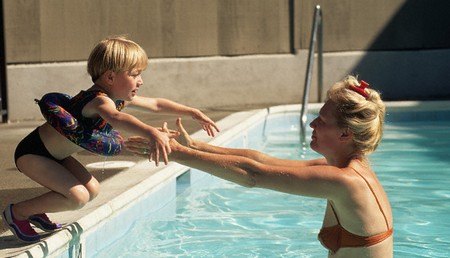The children should be introduced to jumping into the water almost as soon as they start to learn to swim. I like them to know what it feels like, as soon as possible, to be able to go under the water and come up again. This way, in every imaginable emergency situation (falling, slipping, being pushed), they will land with their feet first.
Another great advantage of teaching them how to jump into the water is that the thrill of the jumping sensation counterbalances the fear of putting their faces in the water.
Sit the children on the edge of the pool, have them stretch their arms out, and at the word “Go” gently pull them into the water. On the very first attempt the teacher shouldn’t let their hands go because she will have to help them find their balance as they come up to the surface.
Now make them stand on the edge of the pool and repeat the same procedure by pulling them in by the hand. After a couple of goes, stand back two steps and try to make them do it on their own. The brave ones will jump as if they had been doing it all their fives. But the not-so-brave will look at you with pleading eyes that seem to say,
- “What are you trying to do to me? Teacher, come a bit closer.”
- “No, you try to do it alone. When you get into the water I will fish you out.”
- “But I can’t do it. I’m scared!”
- “When I say, ‘Ready . . . go,’ you jump.”
- “I caaaaan’t!”
This can go on for five minutes, with the poor child deciding he will do it, then at the last moment changing his mind. It’s worth waiting for the Big Moment. The decision has to come from the child, so it is not much good giving him a pull or a shove. Needless to say, after that first jump he will turn around and do it again, and again, and again. If the child is not advanced enough, the jumping, and later on the diving, can be done with the bubble.
To teach the children to dive, line them up at the edge of the pool. Make sure their feet are slightly apart, the toes curling onto the very edge of the pool, knees bent. Their arms should be stretched up above their heads, which should be tucked down.
For the first dive, the teacher should stand beside the child and place one hand on his head (holding it down) and her other hand on his bottom. With a powerful movement, “ease” them into the water. For the second attempt, the teacher should ask the children if they want some help or if they want to do it on their own. Some will say, “I can do it,” and some will sheepishly look at you and say, “Yes, please, help me.”
The difference in individual style is amazing. Some will do a belly flop, some will start off as if they are going to dive but halfway through the air change to a jump. And then, occasionally, some will perform a perfect swallow dive. At this age the teacher shouldn’t correct the clumsy divers. Let them do what they feel like doing. There is plenty of time for improving technique later on.
Jumping and diving without a bubble on is only advisable when children can swim at least five or six yards on their own. Once children have started diving, they will want to do it forever and they will do it when you are not watching, so it is better to make sure they can swim on their own to the edge of the pool. At this age of three to five years, the teacher must remind them again and again how important it is to always be sure that the water is deep enough before they jump or dive.
